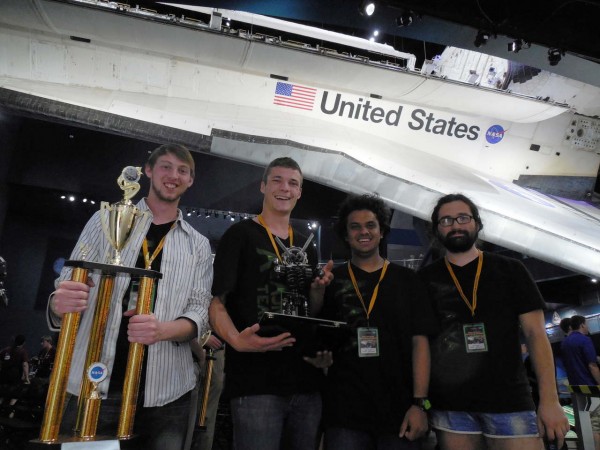UAF robotics team wins innovation award at NASA competition
June 17, 2014
907-474-7902
6/17/14

The University of Alaska Fairbanks' team won the Judge's Innovation Award for its four-wheeled mining robot during the 2014 NASA Robotic Mining Competition last month.
The team's robot is nearly 5 feet wide, weighs just over 100 pounds and is operated via a combination of onboard autonomy and teleoperation. During two 10-minute missions, the robot mined 170 pounds of dusty, simulated Martian regolith — the loose material found on the planet's surface.
The NASA competition judges especially liked the UAF robot's compact stowed configuration. The robot unfolded at startup to a much larger and more stable wheelbase, allowing it to reliably navigate the obstacle field and remain mobile in the fluffy dust.
The team's software also impressed the judges. For example, the fly-by-wire computer vision robot localization system used an onboard wide-angle camera and a large marker, similar to a coarse QR code, to automatically determine the robot's position in the mining arena. This marker blocked the pilot's direct view of the robot, but provided such reliable positioning that it was more useful than directly seeing the robot.
Judges also liked the use of off-the-shelf parts, such as Barbie Jeep wheels and gearboxes, recycled steel and commercial conveyor tracks.
The competition involved five intense days of official competition runs, practice missions and final tuning of hardware and software.
The competition began with a literal bang when an errant wire inadvertently shorted a motor controller input pin, resulting in smoke and fire. Luckily, the team had brought a spare motor controller board. The first practice session started with an unexpected camera dropout, causing the robot to climb a wall and flip onto its back. The team addressed the trouble by adding front bumper hardware and camera error-handling software. The team members also encountered intermittent problems when electromagnetic interference from the motors cut the USB connection. They made mechanical and software fixes to continue operating. The fully autonomous navigation software performed beautifully during testing and an exhibition run, but the robot lost position while crossing the obstacle field during the scored mission runs.
The team's trophy was presented May 23 in Florida at the NASA Kennedy Space Center visitor's complex, directly underneath the space shuttle Atlantis.
The travelling student team members are: Arsh Chauhan, computer engineering; John Pender, computer science; Tyler Pruce, electrical engineering; and Dalton Newbrough,mechanical engineering. The faculty advisor is Orion Lawlor, associate professor of computer science, who donated shop space for the Sunday construction sessions and backyard space for a dusty test area.
Travel support was provided by the UAF College of Engineering and Mines, and the Undergraduate Research and Scholarly Activity program. The team also received help from students Joe Tallan and Aven Bross earlier this year. The team built on a successful basic design constructed last year with Noah Betzen, Robert Parsons and funding from the Alaska Space Grant.
ADDITIONAL INFORMATION: Orion Sky Lawlor, lawlor@alaska.edu, http://www.cs.uaf.edu/~olawlor/
ON THE WEB: http://www.nasa.gov/content/digging-the-dirt-unique-robots-compete-in-mining-competition/#.U5Ywgv3nZeO
NOTE TO EDITORS: A photo of the team with their trophy is available online at //news.uaf.edu/robotics2014/.
SB/6-17-14/353-14


